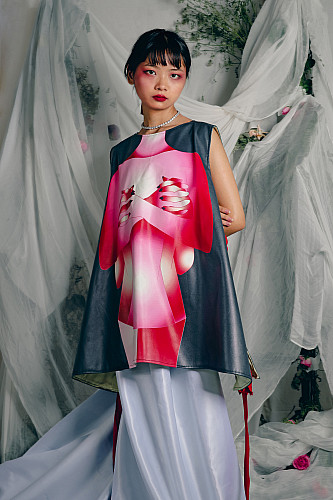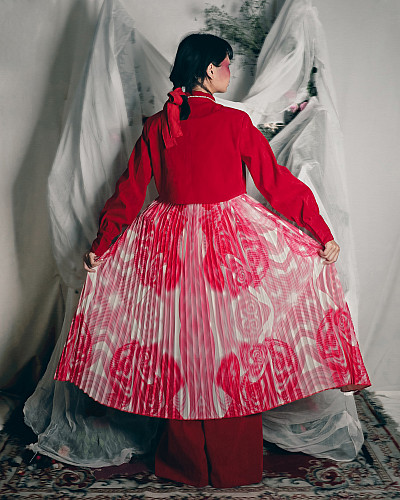
Fashion Forward: Kahkasha Sidra | Verve Magazine
[ad_1]
Interviews, Art Direction and Photography by Asad Sheikh.
Kahkasha Sidra
Degree: Bachelor of Design (Leather Design)
Home town: Patna

How would you introduce your graduate collection?
Belle Epoque: A Beautiful Time is a demi-couture collection consisting of eight complete looks. One word that I’d use to describe it is “romantic”. The looks have been created in pairs, with each one sharing similar design elements to convey the idea of companionship.
What are some underlying concepts — the primary inspirations — behind your collection?
I’ve always wanted to translate my happy memories and beautiful experiences into something tangible; I wished to create something comforting and pleasing to both the wearer and the viewer. The primary inspirations are the memories of my grandfather’s rose garden in Bihar. Whenever I visited them during my summer vacations, I would spend hours with my parents strolling there every evening. It was one of the most beautiful times of my life, so I thought translating it into a collection would be a meaningful start. I was also inspired by the idea of romanticism — the worship of nature, devotion to love and beauty, and the idea of placing imagination above reason. There are a few artistic influences reflected in some pieces as well, inspired by the art nouveau style and [Salvador] Dali’s surrealism.

Tell us about the techniques you have used, your design ideology, and the process and details behind your favourite look from the collection.
My favourite look from the collection is the finale look — a white mesh bridal dress with red suede vegan leather appliqué work. The dress itself does not look complicated, but it was not easy to achieve. I had to study old-school couturiers to create the silhouette of the dress, but at the same time it incorporates a modern surface technique. It took me more than two weeks to make it; the intricate suede leather appliqué was laser cut by digitally placing the motifs on a scanned pattern of the dress. The suede was temporarily fixed onto the mesh fabric with double-sided adhesive, and its edges were then embroidered with rhinestones to fix it permanently.
It’s hard to define my design process; I think it’s a constant string of thoughts and actions. I extract inspiration from experiences and emotions. It’s almost like method acting, starting with identifying the emotions I want to evoke with the collection and then trying to embody those in everything I do. The only ideology I follow while designing is to create something that can stir the senses even without any knowledge of art or design.


Conversations around personal representation are becoming increasingly prominent in today’s fashion world. In that regard, how would you say your work reflects who you are?
I am here because of these cultural conversations. Human civilisation has progressed enough that we don’t need more people to make clothes only for the sake of it. It is about representation; it is about seeing someone on the other side of the globe wearing clothes designed by, say, a hijabi South-Asian designer from Patna. These representations don’t just hold cultural value; they are of monetary value as well and mean a lot for our community of skilled manpower that is often exploited. It is about being perceived as a creator and not just a producer.
Visually, I think a lot of Bihari as well as Islamic sensibilities are reflected in my work very subconsciously, whether in the form of cuts and styling derived from traditional silhouettes, colour combinations or surface embellishments. I like the idea of bringing elements from Bihari Muslim households into my image creation as well.

Where do you think fashion is going with AI and the metaverse?
AI is very instinctively incorporated in the process of this era of creatives, whether it’s used in design, production, presentation or advertising. As someone who’s trying to understand the global market, I find things like trend forecasts to be very helpful. Communicating with followers using personalised AI filters is one thing I wish to try soon too. But on a macro scale, I think it’s going to take some time for both creators and consumers to understand these concepts and their applications.
How has the shift towards digital fashion affected your creative process?
I like to remain free from the pressure of participating in this shift towards digital fashion. I think there is certainly an audience for that and some incredible things are already happening. But as a designer, I believe in the physicality of things, in mastering the craft of dressmaking. In witnessing someone twirl in my garments at fittings. I do, however, believe that catching up with digital tools is important, and I utilise various techniques like UV printing, laser cutting and pleating, and wish to experiment with 3D printing as well.


Do you feel digital design is the answer to fashion’s waste problem?
No. I think digital designs are an exciting addition to fashion. But people still need real clothes to wear. Fashion’s waste problem needs to be addressed on a physical and psychological level. There is overproduction because there is an over-demand, so it starts with the consumer’s mindset.
I think it’s too soon to conclude that digital fashion is sustainable as well — just as we recently got to know about the carbon footprint that is left by emails, we may find a similar fallout in the case of NFTs as well. Ethical buying practices, setting high standards for quality and utilising efficient digital tools for zero-waste production may contribute more.
According to you, where is the world of design and fashion heading?
Indian fashion is unapologetically returning to our age-old silhouettes. In terms of design, it is undergoing a transformation in its narratives. Eurocentric ideas of what is expected of an Indian designer on a global platform are changing. Unexpected aesthetics are emerging, and I think that just as we had the avant-garde trio from Japan or the Antwerp Six from Belgium, the next decades are going to be about the new-school designers from India.
Previous: Anya Wahi
Next: Purvasha Singh
[ad_2]
Source link


